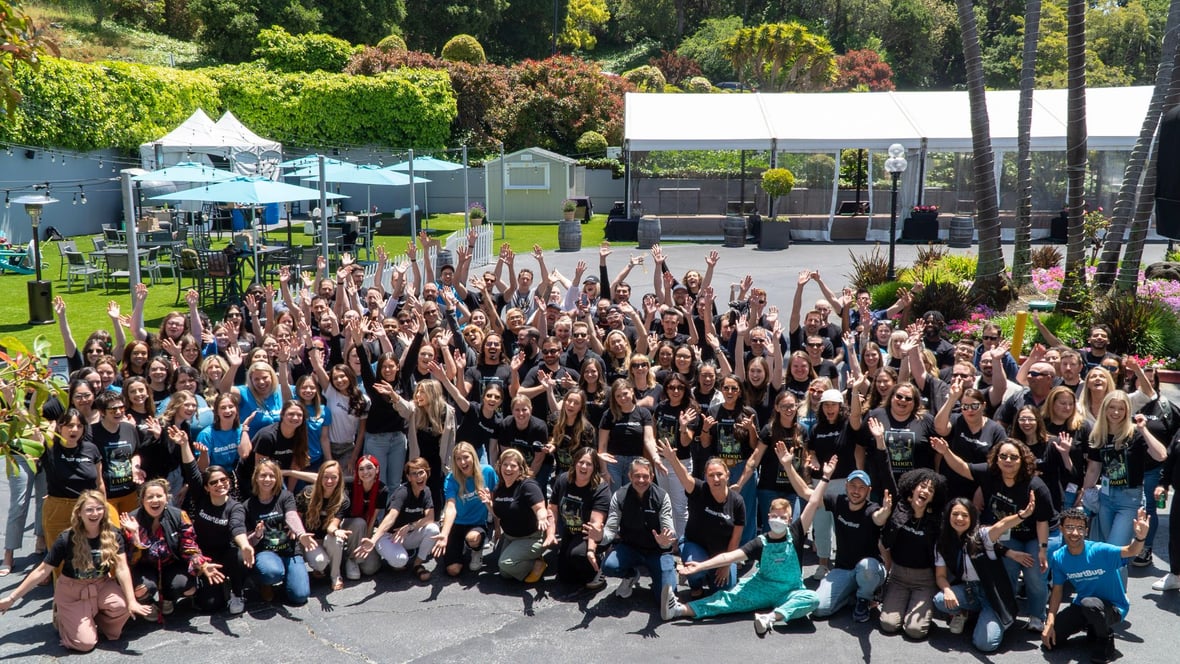
By Rachel Dong
Guest author Rachel Dong is an associate marketing manager on the SEO team at HubSpot
How did SmartBug, a full service digital agency and an elite HubSpot partner, go from a company of one employee to 200 strong—and do so while being completely remote?
At HubSpot’s INBOUND 2023, SmartBug CEO Jen Spencer answered this question by sharing her unique perspective on building a remote-first, employee-friendly work environment. A former educator, she conceptualizes remote work through psychologist Abraham Maslow’s hierarchy of needs. Maslow proposed a pyramid with five levels, each level of which must be met sequentially for a person to function optimally (and achieve what he calls “self-actualization”).
Spencer explained the pyramid’s connection to remote work: The pyramid encapsulates employees’ needs to maximize productivity. Additionally, she gave real-life examples of practices SmartBug implemented to fulfill each need. These are practices every company can learn from and implement.
Here are the four key levels for fulfilling and productive remote work, according to Spencer.
1. Physiological Needs
The base level, physiological needs, seems straightforward; it encompasses basic bodily needs such as hunger, thirst, and health. But Spencer emphasized a layer often overlooked: rest.
With SmartBug allowing flex time in the workday, employees are empowered to take a break and recharge when they need to. Instead of a strict 9-5 each day, team members can work based on their natural circadian rhythms and embrace their bodies’ natural timings. Employees have the flexibility to identify their most productive time of the day—whether they are early birds or night owls—and leverage that time to accomplish their work efficiently.
Have you ever felt embarrassed that you couldn’t match those influencers’ 5 a.m. wake-up-and-grind schedules you see online? Spencer certainly has. But she’s learned that there’s no point in forcing yourself to follow someone else’s schedule. She’s also learned that there’s certainly no point in enforcing that green “online” status beside employees’ usernames every minute of the day. At SmartBug, Slack statuses including “Taking a break” and “Lunch break” are pre-added in the system, normalizing the policy of stepping aside (or even outside!) to recharge when needed.
These practices allow employees to meet their basic physiological needs more easily. As Spencer put it: “We want people to be human beings and take care of themselves.”
2. Safety Needs
The second level includes safety needs—both physical and mental. As it relates to remote workplaces, mental and psychological safety looks like feeling welcomed in one’s team and company.
This includes business transparency. Spencer astutely notes that if you don’t let your employees know what’s going on in the company, they will create a narrative for themselves. Keeping employees in the know about business happenings is crucial to creating a safe, healthy, and accountable work environment.
Additionally, Spencer touched on safety including the ability to come to work as your authentic self. She noted how, especially for women, there are heavy expectations around what “professional” looks like. But for Spencer, it’s crucial to normalize looking real—that is, not looking like some forced version of your “best” all the time. In practice, this includes attending a meeting sweaty from the gym or having just recovered from an illness.
The last aspect of workplace safety Spencer emphasized was supporting employees’ professional development. SmartBug has a tradition of holding quarterly Certification Days, when all business operations are shut down to allow employees to pursue professional certifications. In fact, this practice was the inspiration for HubSpot’s very own World Certification Week!
By practicing transparency, authenticity, professional certification, and career support, you can create a safer remote work experience for your employees.
3. Love and Belonging Needs
The third level of the pyramid encapsulates people’s need for a sense of connection. Solid effort in this realm proves to be more important in a remote company, where it can be all too easy to feel isolated and disconnected.
SmartBug fosters connection through the annual event “SmartBugapalooza,” where SmartBug employees gather in person to experience team bonding time, educational training sessions, and—perhaps the most crucial aspect—free days to do whatever their heart desires.
Enthused, Spencer described the most recent SmartBugapalooza free day: Employees organized in groups to do all sorts of fun things, from exploring new areas to spending time in nature. Many employees found it to be a meaningful experience because they made new friends and engaged in and visited locations they wouldn't have otherwise.
SmartBug also provides funding for “IRLs,” or in-person meetups among employees where each person can expense up to $50. Each year, photos from the previous year’s IRLs are compiled into a presentation that showcases the SmartBug spirit.
There are also plenty of intra-SmartBug special interest groups via Slack channels where employees can chat about a shared passion or identity. Popular special interest groups include music, video gaming, and ladybugs (for female SmartBug employees).
When given plenty of opportunities for internal friendships and connection, even remote employees can experience a concrete feeling of belonging in the workplace.
4. Esteem Needs
The fourth level of the pyramid, esteem, describes each person’s natural desire for recognition, respect, and positive self-image.
At SmartBug, this manifests in paid sabbaticals to recognize loyal employees who have worked there for a certain amount of time. Furthermore, at each SmartBugapalooza, awards are given to recognize achievement and commitment. Employees nominate their colleagues and then vote for each award ahead of the annual conference. Spencer recognizes the award ceremony as her favorite part of the year—a heartwarming culmination and recognition of people’s hard work.
How Can You Apply These Insights to Your Remote Workplace Culture?
During her INBOUND session, Spencer said that when you satisfy all these levels of employees’ needs, you pave the way for them to reach self-actualization. In other words, you empower your employees to become the best, most productive version of themselves. Self-actualized employees work better, smarter, and—most of all—happier.
Learning from Spencer and SmartBug’s model for remote work, we can understand how to cultivate remote employee’s motivation, satisfaction, and success. Even remotely, we can nurture an environment where all employees can thrive and achieve their full potential.

About the author
Rachel Dong is an associate marketing manager on the SEO team at HubSpot. She is a graduate of Tufts University and is passionate about all types of content—writing, design, video, and more. Read more articles by Rachel Dong.


















%20copy.png?width=200&height=260&name=e-book%20covers%20(4)%20copy.png)



